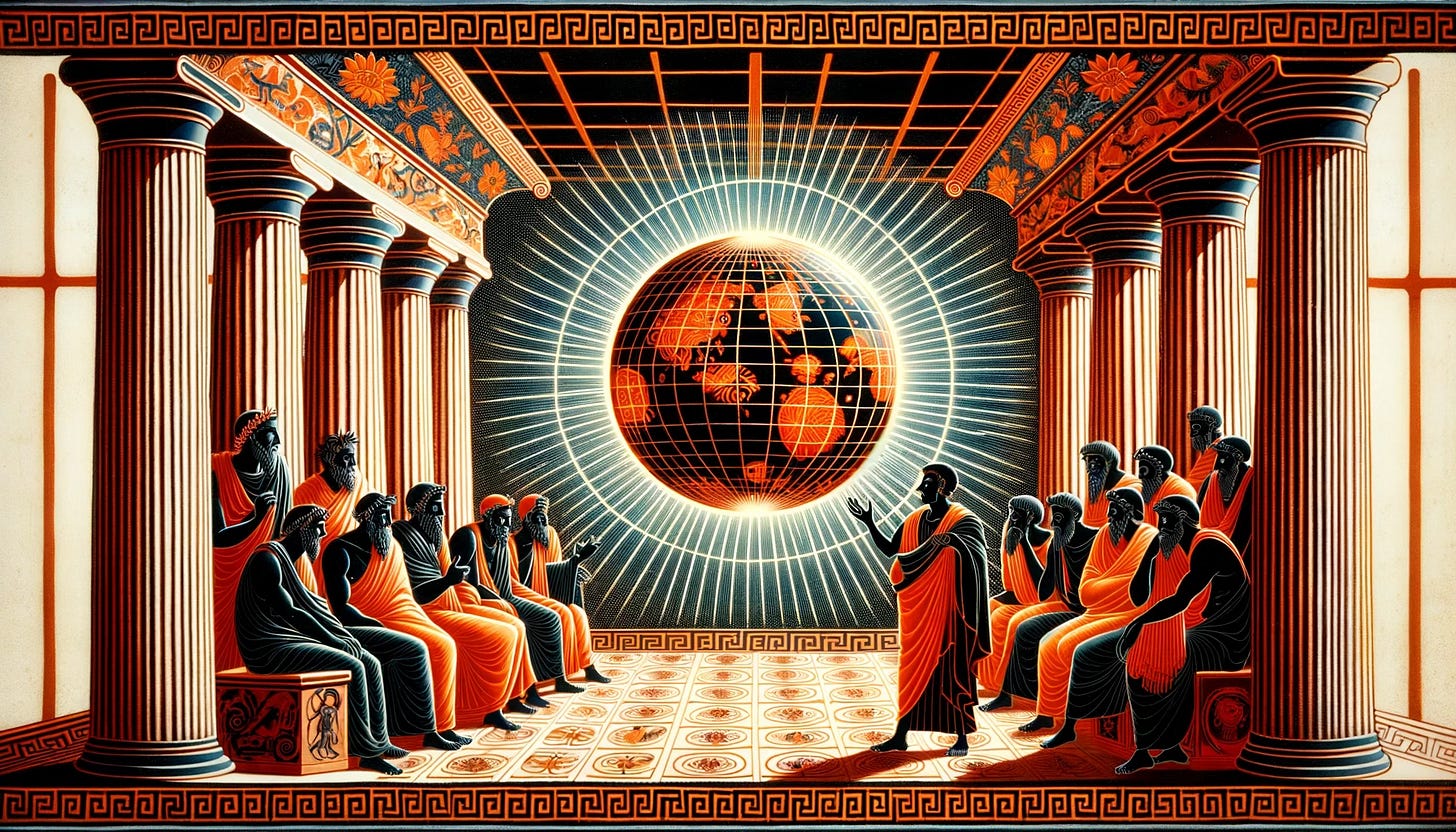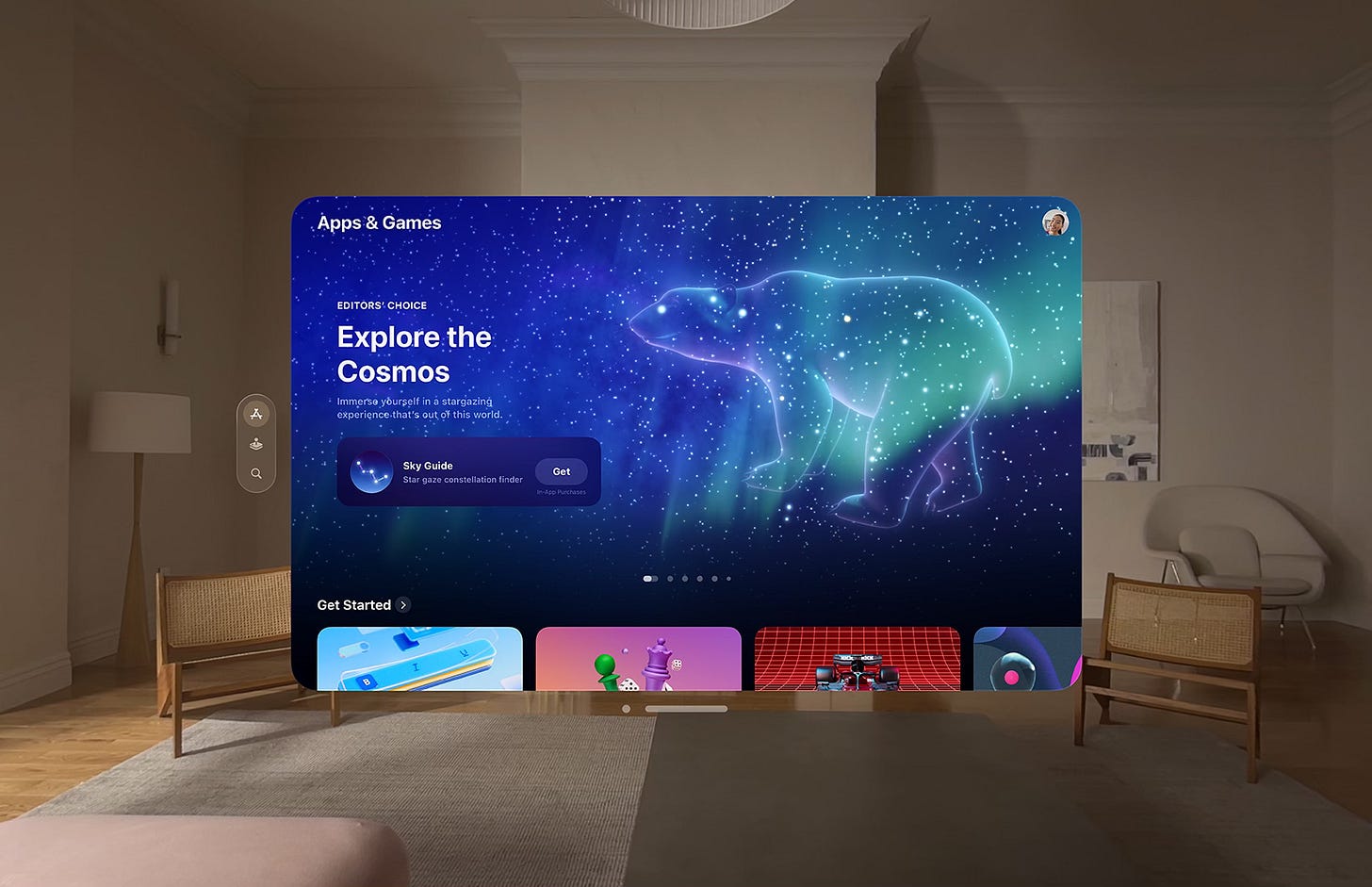The Spatial Battle Has Begun
Depicted above (thanks to DALL-E) is a passionate debate on the nature of reality between Plato and Aristotle, and how they might respond when faced with the addition of a holographic globe.
I’ve spent more than a decade in the worlds of Mixed Reality (MR) and Spatial Computing, and I have never been more excited. This year, I believe, marks a crucial turning point not only for the industry but for the future of human-computer interaction as a whole.
2024 brings the first real competitive challenge to Meta’s 8-year hold over the world of Mixed Reality. Apple (along with many others) have arrived not only with new hardware but a very different philosophy for how we create this new medium.
Although many will be hypothesizing about what the killer app or use case for MR, I think the future requires us to think much more deeply – about reimagining the core foundational technologies that will drive our 3D experience.
The Divergent Philosophies of Mixed Reality - The Coming Conflict
At the heart of this transformative phase lies a fundamental divergence in development philosophies. On one side, we have Apple's Vision Pro, championing a mobile app-inspired approach, emphasizing user-friendly interfaces and familiar experiences. I foresee this camp also being joined by players like Samsung and Google, who lean towards a philosophy grounded in mobile application sensibilities.
Contrasting this is the video game design philosophy, spearheaded by Meta and their Quest hardware. Focused on highly immersive and gaming-inspired experiences, this approach is also mirrored by companies like Sony and Pico (ByetDance).
These two camps, though different in their core ideologies, are shaping the future of MR and Spatial Computing in profound ways - but whose philosophy will prevail?
The Battle Lines Drawn
The conflict underpinning these philosophies is not just about hardware choices but also about the narrative they craft in user experience.
Apple's approach, apparent when exploring the developer documentation for visionOS & the Vision Pro, carries over foundational norms of mobile and 2D applications. The traditional windowed motif, a framed box bounding content, continues to be their central way of grounding the user, with 3D and immersive experiences building outwards from them. For developers, whenever you open a new view in Vision Pro, the default is a window, not an immersive space. This leads to incredibly intuitive user experience design - but by default less immersive, more multifunctional use cases.
Apple’s promotional material for Vision Pro and Spatial Computing is approachable, intuitive, and grounded.
In contrast, Meta’s vision carries over game development philosophies from early VR, like Oculus. From the outset, each new app opened tends to transform the user’s environment more extensively, with 3D asset interaction being central even in their Mixed Reality experiences. Meta’s documentation for developers focuses almost exclusively on game engines, Unity, and Unreal. From the outset the Meta Quest user interacts with 3D, more diegetic content you can push, prod or grab it as if it were a real thing. This is, by design, an unexpected experience for those less used to gaming - but is in fact more immersive and arguably more immediately delighting.
Meta’s Mixed Reality materials are diegetic, interacting with the world and exploding out, with new interface designs pushing a sense of immersion.
This divergence is more than a matter of preference; it's a reflection of how these companies envision the role of MR in our lives. Apple's strategy suggests seamless integration of MR into our current digital ecosystem. Meta's approach indicates escapist, alternative reality experiences blending into our real world.
Where to Find Opportunities Today
We can’t yet say who will win this philosophical battle of experience - we will see in the coming months how developers and users react.
To do this, firstly, we need to identify where MR and Spatial Computing lag behind the existing worlds of Gaming and Mobile development. Rather, asking the question: what does it take for the maturity of these two developer environments to converge?
Today we have very mature infrastructure for developers to create delightful, useful, and stable products in 2D, products that can be monetized in predictable and well-understood ways. However, the toolsets necessary to fulfill these products equivalent 3D potential either don’t currently exist or require significant overhauls for the demands of mixed reality/spatial computing. Although much has been done - see WebXR, OpenXR, and an array of 3D creator tools out there (AI or otherwise) - there are still myriad areas where what is considered standard for the world of 2D applications simply hasn’t been developed for MR and Spatial Computing. Quick examples include asset/content streaming of model assets, data capture that understands environments, spatially aware advertising/monetization and cross-application interaction (something as simple as 3D’s version of copy-paste).
The solutions to this infrastructure layer, built with a deep understanding of how the industry is evolving, will power the killer applications of MR/Spatial Computing’s future.
We Can Do Better
At this point, it’s tempting to turn to mobile gaming for inspiration, as it sits at the intersection between these two worlds.
However, I’d like to encourage us all to demand better.
In many ways, mobile gaming has become the poster child for everything wrong with our digital lives. Monetization models that prey on users through gambling mechanics and loot boxes; poorly optimized applications filled with advertising bloat, and deeply intrusive data capture that uses the user as a product to be manipulated. We stand at a tipping point of a new medium and a new relationship between our physical and digital lives. We must do better than to fall into these same traps.
Simply embracing the last broken system as a means of creating the next is, in my mind, a guarantee that we never manage to embrace the full potential of this next digital age.
Conclusion
This year is more than just a new chapter in the story of mixed reality and spatial computing; it is a foundational shift in the narrative of human-computer interaction. The battle between the mobile-inspired approach of Apple and the immersive gaming-centric philosophy of Meta represents a critical juncture in the evolution of this technology. As developers and investors navigate this landscape, understanding and adapting to these divergent paths will be key to harnessing the full potential of MR and spatial computing. We stand at the threshold of a new era, one that promises revolutionary changes in how we interact with our digital and physical worlds. There are exciting new opportunities to shape it in ways that put the user first.
This is the first in a series of posts I will be releasing outlining a thesis on the future of Spatial Computing. For complete transparency, I, along with some incredibly talented industry veterans, have started a new venture building foundational technology for this future of Spatial Computing & Mixed Reality. Subscribe to hear more…I always love a good debate on LinkedIn too!




